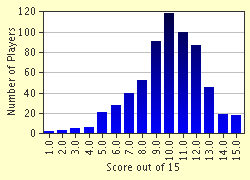Quiz Answer Key and Fun Facts
1. John Chapman collected the pits from many cider mills. He took these seeds and planted them throughout the Midwest, United States. He tended these apple nurseries and offered the small plants to the settlers as they moved west. He did this so that pioneers making their way west would have fresh fruit to eat. This man was known as:
2. An American gardener interested in xeriscape would surely garden in which of the following states?
3. A gardener decides to place a bird feeder in the garden to feed finches. The feeder selected is a thistle feeder. The gardener hesitates to use this feeder, fearing that thistles will invade the garden. Why is this not a real threat?
4. A gardener notices that there is a weed in the garden that looks like yellow and red threads with no leaves. It appears to attach itself to the desired plants and these host plants are rapidly declining. This weed is:
5. Chipmunks and squirrels have been eating many of the gardener's spring bulbs. Which one of the following bulbs would be least likely to be eaten?
6. The tomato plants started on the windowsill become very "leggy" before they can be placed out in the garden. What is the term for this condition?
7. If a seed has a tough seed coat, it may take a long time for the seed to germinate. You can hasten the procedure by nicking the seed or treating with acid to break the seed coat. What is this procedure called?
8. A gardener buys a blue hydrangea, and two years later he notices it turned pink. Why did this happen?
9. If an ornamental pear tree (such as a Bradford variety) is grafted with a scion from a fruiting variety (for example a Bosc variety) is it possible to get a full sized pear fruit?
10. A gardener is contemplating buying some fruit trees. He is looking at the varieties: Winesap, Delicious, and Baldwin. What kind of orchard is he planning?
11. A frost is expected tonight and the orchard is in full bloom. The gardener expects to turn on overhead sprinklers when the temperature reaches 33 degrees Fahrenheit. Will this save the crop?
12. A gardener decides to plant a Redhaven peach pit. Will this definitely grow into another Redhaven peach tree?
13. Bees and hummingbirds are known to be important pollinators. Are there any nonhuman mammals which are also pollinators?
14. The horticulturist Luther Burbank was responsible for many new plants including the Shasta daisy, and the Santa Rosa plum.
15. The most important reason for trying to keep exotic new pests from entering another country is that there may not be any natural predators to keep the pest in check.
Source: Author
egstrasser
This quiz was reviewed by FunTrivia editor
Bruyere before going online.
Any errors found in FunTrivia content are routinely corrected through our feedback system.

